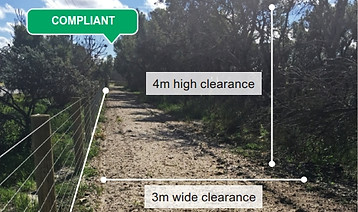
New to Banjup
Here you can find information and guidance about managing a property in Banjup

Drinking Water
There is no scheme water in Banjup.
Many residents have rain water tanks filled by the winter rains. If that runs out, then get water carted in.
Other residents have a bore that draws water from 40 metres down. Generally, it is safe to drink but rely on your own testing to make sure.
Bore water has a colour comparable to weak whisky and soda.

Fire Breaks
Every property in Banjup is required to have a 3 metre wide clear track around its boundary. During the 'fire season' between 1 November and 15 April, the City of Cockburn inspects fire breaks for compliance.
See here for more Fire Safety information.

Irrigation Bores
Bore water on Banjup properties is typically used for irrigating lawns, veggie patches, and fruit trees.
Legislation mandates that garden bores may only be used twice a week between certain hours. However, in the interest of maintaining a 20 metre wide "asset protection zone" around Banjup residences, a landowner can apply to use a bore 3 times a week. Go to Apply for approval to irrigate on a three-day sprinkler roster - Be Groundwater Wise

Noise Nuisance
The same noise nuisance legislation applies in rural Banjup as applies anywhere in suburbia. This includes inordinate use of trail bikes, chain saws, and like machinery. Loud music and parties are also subject to the same legislation.
Banjup residents respect each other's peace and tranquillity.

Sewage
There is no main sewerage in Banjup.
Many properties have a 2 or 3 stage septic tank system that leads into a leach drain.
Newer properties have more sophisticated system.

Bonfires and Burning
No fires may be lit during the "prohibited burning time", typically December until March but may be varied by the City of Cockburn depending on the weather conditions.
With a permit issued by the City of Cockburn, fires may be lit during the "restricted burning time", typically during the months of October, November, April, and May but, again the City of Cockburn may vary the period. Apply for a fire permit at https://www.cockburn.wa.gov.au/Health-Safety-and-Rangers/Fire-and-Emergency-Management/Bushfire-Prevention/Fire-permit-request
Fires may be lit without a permit during the "unrestricted burning time" of June, July, August, and September.

Wlidflowers
Many species of wildflowers bloom on Banjup properties during spring. 20 of them are described on this site here

Weeds
Unfortunately, many species of weeds, both native and exotic, grow on Banjup properties during spring. A dozen of them are described on this site here.
Invest time and effort in controlling them before they become a fire hazard.

Annual Tasks
January
Walk firebreaks and keep them clear
Irrigate and maintain Asset Protection Zone
see page here
Irrigate and maintain non-native plants
February
Walk firebreaks and keep them clear
Irrigate and maintain Asset Protection Zone
Irrigate and maintain non-native plants
March
Walk firebreaks and keep them clear
Irrigate and maintain Asset Protection Zone
Irrigate and maintain non-native plants
Collect dead trees and branches ready for bonfires
April
Walk firebreaks and keep them clear
Irrigate and maintain Asset Protection Zone
Irrigate and maintain non-native plants
Collect dead trees and branches ready for bonfires
Burn dead vegetation on bonfires after 15 April – permit required
May
Irrigate and maintain Asset Protection Zone
Irrigate and maintain non-native plants
Burn dead vegetation on bonfires – permit required
June
Burn dead vegetation on bonfires – keep dry under tarpaulin as necessary
Apply glyphosate (broad spectrum herbicide) to spots of emerging capeweed and annual and perpetual veldt grass
July
Apply glyphosate to emerging capeweed and annual and perpetual veldt grass on firebreaks and paths.
Apply fluazifop (grass specific herbicide) to emerging capeweed and annual and perpetual veldt grass in natural bushland
August
Apply glyphosate to all weeds on firebreaks
Apply fluazifop to capeweed and annual and perpetual veldt grass in natural bushland
September
Clear firebreaks to mandatory widths and heights
Apply glyphosate to all weeds on firebreaks
Apply fluazifop to capeweed and annual and perpetual veldt grass in natural bushland
Burn dead vegetation on bonfires
October
Irrigate and maintain Asset Protection Zone
Irrigate and maintain non-native plants
Clear firebreaks to mandatory widths and heights
Rake windrows of leaves and twigs from firebreaks
Burn dead vegetation on bonfires – permit required
November
Expect firebreak inspection by a Cockburn ranger
Walk firebreaks and keep them clear
Irrigate and maintain Asset Protection Zone
Irrigate and maintain non-native plants
Burn dead vegetation on bonfires – permit required
December
Walk firebreaks and keep them clear
Irrigate and maintain Asset Protection Zone
Irrigate and maintain non-native plants